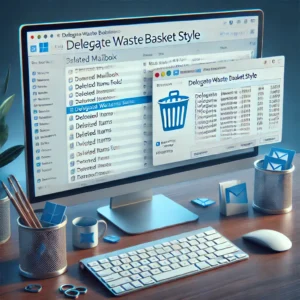 Managing shared mailboxes in Outlook can be challenging, especially when it comes to controlling where deleted items go. The DelegateWastebasketStyle setting in Outlook shared mailboxes plays a crucial role in determining whether deleted emails are stored in the delegate’s Deleted Items folder or the mailbox owner’s folder.
Managing shared mailboxes in Outlook can be challenging, especially when it comes to controlling where deleted items go. The DelegateWastebasketStyle setting in Outlook shared mailboxes plays a crucial role in determining whether deleted emails are stored in the delegate’s Deleted Items folder or the mailbox owner’s folder.
In this guide, we’ll explain how DelegateWastebasketStyle works, how to change its settings via the registry, and how to ensure deleted items are stored in the correct folder.
What is DelegateWastebasketStyle in Outlook?
DelegateWastebasketStyle is a Microsoft Outlook setting that controls where deleted items from shared mailboxes or delegated mailboxes are stored.
By default, when you delete an item from a shared mailbox, it ends up in your own Deleted Items folder (as the delegate). However, you can configure this setting so that deleted emails are stored in the mailbox owner’s Deleted Items folder instead.
Why Is DelegateWastebasketStyle Important?
When working with shared mailboxes—common in corporate environments for customer service, HR, or admin teams—it’s crucial to know where deleted emails are going. Misplaced or vanished emails could lead to confusion or missed communication. With the right Outlook registry setting, you can decide whether deleted emails go to the delegate’s folder or the shared mailbox owner’s folder.
How to Modify DelegateWastebasketStyle in the Registry
To change where deleted items are stored in a shared mailbox, you need to adjust the registry setting for DelegateWastebasketStyle. Follow these steps:
1. Close Outlook
Before making changes, close Outlook to avoid conflicts.
2. Open Registry Editor
- Press Win + R, type
regedit, and hit Enter. - Navigate to the following registry location:
In this path, replace x.0 with your version of Outlook (e.g., 16.0 for Outlook 2016/2019/365).
3. Modify DelegateWastebasketStyle
- Locate or create a new DWORD (32-bit) Value called DelegateWastebasketStyle.
- Set the value to:
- 8: Store deleted items in the delegate’s Deleted Items folder (default).
- 4: Store deleted items in the mailbox owner’s Deleted Items folder.
4. Restart Outlook
Once you’ve made the change, restart Outlook to apply the new settings.
Key Considerations for Shared Mailbox Settings
- Permissions: If you set DelegateWastebasketStyle to 4 (mailbox owner’s Deleted Items folder), the delegate needs at least Author-level permissions for that folder.
- Group Policy: This setting can also be applied through Group Policy for larger organizations, allowing IT admins to control this behavior across multiple users.
- Troubleshooting: If you encounter issues, like not being able to delete items, check the permissions on the owner’s Deleted Items folder.
Conclusion:
The DelegateWastebasketStyle setting in Outlook is a powerful tool for managing shared mailboxes. By adjusting this setting in the registry, you can control whether deleted items go to the delegate’s Deleted Items folder or the mailbox owner’s folder. Make sure to set the appropriate permissions to avoid any issues with deleted items.
Managing shared mailboxes efficiently can prevent confusion and ensure that important communications are not lost.

I want to thank you for your assistance and this post.